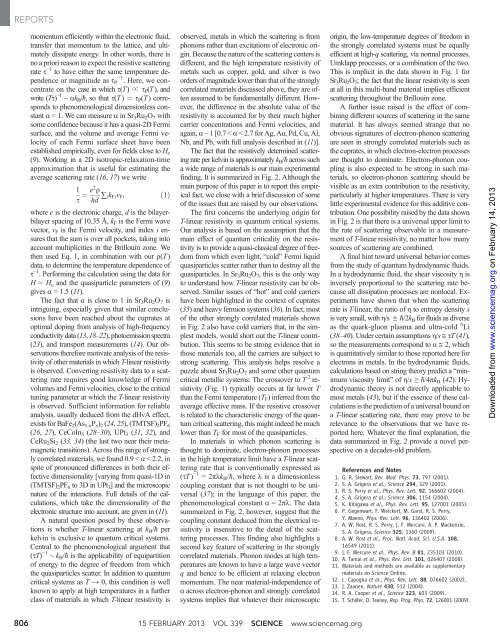et al.
et al.
et al.
Create successful ePaper yourself
Turn your PDF publications into a flip-book with our unique Google optimized e-Paper software.
REPORTS<br />
806<br />
momentum efficiently within the electronic fluid,<br />
transfer that momentum to the lattice, and ultimately<br />
dissipate energy. In other words, there is<br />
no a priori reason to expect the resistive scattering<br />
rate t −1 to have either the same temperature de-<br />
−1<br />
pendence or magnitude as tP . Here, we concentrate<br />
on the case in which t(T) º tP(T), and<br />
write (Tt) −1 ~ akB/ħ, sothatt(T) ¼ tP(T) corresponds<br />
to phenomenologic<strong>al</strong> dimensionless constant<br />
a = 1. We can measure a in Sr3Ru2O7 with<br />
some confidence because it has a quasi-2D Fermi<br />
surface, and the volume and average Fermi velocity<br />
of each Fermi surface she<strong>et</strong> have been<br />
established empiric<strong>al</strong>ly, even for fields close to Hc (9). Working in a 2D isotropic-relaxation-time<br />
approximation that is useful for estimating the<br />
average scattering rate (16, 17) wewrite<br />
1<br />
t ¼ e2r hd ∑ikFivFi ð1Þ<br />
where e is the electronic charge, d is the bilayerbilayer<br />
spacing of 10.35 Å, kF is the Fermi wave<br />
vector, vF is the Fermi velocity, and index i ensures<br />
that the sum is over <strong>al</strong>l pock<strong>et</strong>s, taking into<br />
account multiplicities in the Brillouin zone. We<br />
then used Eq. 1, in combination with our r(T)<br />
data, to d<strong>et</strong>ermine the temperature dependence of<br />
t −1 . Performing the c<strong>al</strong>culation using the data for<br />
H=Hc and the quasiparticle param<strong>et</strong>ers of (9)<br />
gives a =1.5(11).<br />
The fact that a is close to 1 in Sr3Ru2O7 is<br />
intriguing, especi<strong>al</strong>ly given that similar conclusions<br />
have been reached about the cuprates at<br />
optim<strong>al</strong> doping from an<strong>al</strong>ysis of high-frequency<br />
conductivity data (13, 18–22), photoemission spectra<br />
(23), and transport measurements (14). Our observations<br />
therefore motivate an<strong>al</strong>ysis of the resistivity<br />
of other materi<strong>al</strong>s in which T-linear resistivity<br />
is observed. Converting resistivity data to a scattering<br />
rate requires good knowledge of Fermi<br />
volumes and Fermi velocities, close to the critic<strong>al</strong><br />
tuning param<strong>et</strong>er at which the T-linear resistivity<br />
is observed. Sufficient information for reliable<br />
an<strong>al</strong>ysis, usu<strong>al</strong>ly deduced from the dHvA effect,<br />
exists for BaFe2(As1-xPx)2 (24, 25), (TMTSF)2PF6<br />
(26, 27), CeCoIn5 (28–30), UPt3 (31, 32), and<br />
CeRu2Si2 (33, 34) (the last two near their m<strong>et</strong>amagn<strong>et</strong>ic<br />
transitions). Across this range of strongly<br />
correlated materi<strong>al</strong>s, we found 0.9 < a





